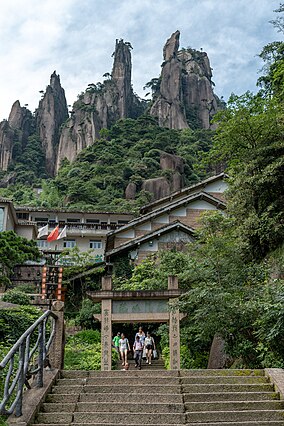Mount Sanqing
| Sanqingshan National Geopark | |
|---|---|
 | |
| Location | Jiangxi,China |
| Nearest city | Shangrao |
| Coordinates | 28°54′57″N118°3′52″E/ 28.91583°N 118.06444°E |
| Area | 229.5 km² |
| Established | 2005 |
| Official name | Mount Sanqingshan National Park |
| Criteria | Natural: (vii) |
| Reference | 1292 |
| Inscription | 2008 (32ndSession) |
| Area | 22,950 ha (56,700 acres) |
| Buffer zone | 16,850 ha (41,600 acres) |
Mount Sanqing(Chinese:Tam thanh sơn;pinyin:Sānqīng Shān) is a renownedTaoistsacred mountain located 40 kilometres (25 mi) north ofYushan CountyinJiangxi Province.Sanqingmeans the "Three Pure Ones"in Chinese as Mount Sanqing is made up of three main summits: Yujing, Yushui, and Yuhua, representing the Taoist trinity.
AChinesephrase “Tam phong tuấn bạt, như tam thanh liệt tọa kỳ điên” ( “Three steep peaks, like theThree Pure Onessit the summits” ) explains why it was namedSan Qing.Amongst the three hills, the Yujing hill (1817 meters abovesea level) is the highest.
Mount Sanqing is the highest of theHuaiyu Mountainsand is known for its outstanding scenery and unique geological formations.[1]The area became a National Geopark in 2005, and aUNESCOWorld Heritage Sitein 2008.[2][3] It is a famous tourist destination as well as a refuge for animals and plants. The national park contains more than 2300 species ofplantsand 400 species ofvertebrates.[4]The total area of Mount Sanqing is 229 km².
Geological History and Hydrology[edit]
Mount Sanqing is a granite mountain that forms a part of acrustal suturezone dating back to theNeoproterozoic Era,roughly 850 million years ago.[4]However, the granite making up much of the mountain peaks dates from theMesozoic.Faulting,weatheringanderosionhave shaped the mountains into intricate landforms. On Mount Sanqing, there are more than 23 gorges with more than 500 meters of elevation.[4]The abundant yearly rainfall in the region allows for many waterfalls (some of which are over 60 meters in height), pools, and springs in the region.[1]
Biodiversity[edit]
Located in ahumid subtropicalclimate zone, Mount Sanqing and the surrounding national park is relatively biodiverse. Over 2300 plant and 400 vertebrate species have been described within the park boundaries, some of which are threatened with extinction.[4]
Flora[edit]
There are many vegetation types in Mount Sanqing, including evergreen broad-leaved forests, warm temperate coniferous forests, warm temperate needle and broad-leaved mixed forests, bamboo forests, temperate needle and broad-leaved mixed forests, evergreen and deciduous broad-leaved mixed forests, coppice forests, and mountain top meadow coppice forests.[4]This, coupled with the isolated topography of the region and its status as an Ice-Agerefugium,has allowed high rates of floral biodiversity andendemism.[4]Mount Sanqing protects many conifer species in particular, including rare varieties ofPseudotsuga sinensisgausseniiandTsugaspp.[4]19 of the plants found in the park were listed on the IUCN Red List as of 2003.
Fauna[edit]
Because of the large elevational gradients on and around the mountain and the corresponding variation in habitat, the fauna of the region display clearniche differentiationalong the mountainside. 61 mammal, 226 bird, 49 reptile, 23 amphibian, 36 fish, and 1327 insect species have been found within the park.[4]37 of these species are endemic to China, including theTibetan macaque,Chinese hare,Yellow bittern,Cabot's tragopan,Yellow-bellied tit,andChinese fire belly newt.Like much of Southern China, the mountain is rich ingallinaceousbirds. It also protect a wide diversity of butterfly species.[4]The critically-endangeredBlue-crowned laughingthrush,of which fewer than 200 individuals likely remain, has been sighted in the park.[4]Leopards,pangolins,andseroware common in the park.
Gallery[edit]
-
Map of the site
-
Cable car
-
Pine tree on a mountain top
-
The San Qing temple
-
Snake rock
-
South slope of Sanqingshan in fog
-
Sanqingshan's Longevity Garden in fog
-
Sunrise at Sanqingshan, with the Giant Python Emerging from the Mountain
References[edit]
- ^ab"Mount Sanqingshan National Park".UNESCO World Heritage Centre.United Nations Educational, Scientific, and Cultural Organization.
- ^"Sanqingshan Geopark".Global Geoparks Network.Retrieved8 February2015.
- ^Canadian fossil park, an Icelandic volcanic island and archipelago in Yemen among sites added to UNESCO World Heritage List
- ^abcdefghijMount Sanqingshan National Park(PDF)(Report). Ministry of Construction of People’s Republic of China.Retrieved11 Apr2021.





















